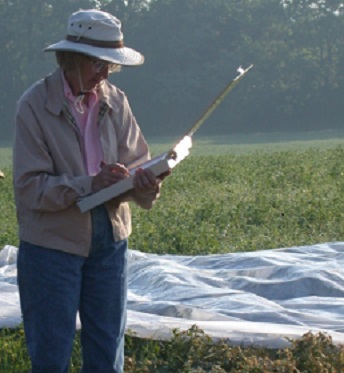Last updated: March 16, 2022
Lesson Plan
Women in Archeology: Dr. N’omi Greber’s Contributions to Hopewell Archeology

- Grade Level:
- Middle School: Sixth Grade through Eighth Grade
- Subject:
- Literacy and Language Arts,Science,Social Studies
- Lesson Duration:
- 90 Minutes
- State Standards:
- State of Ohio, Social Studies and Science, Grades 6 -8
RL.6.1
RI.6.1
RI.6.2
RI.6.7
SS.6.3
SS.7.1
SS.7.12
GS.7.13
RL.8.1
SS.8.1
SS.8.16
GS.8.17
GS.8.18
GS.8.20 - Thinking Skills:
- Understanding: Understand the main idea of material heard, viewed, or read. Interpret or summarize the ideas in own words. Applying: Apply an abstract idea in a concrete situation to solve a problem or relate it to a prior experience. Evaluating: Make informed judgements about the value of ideas or materials. Use standards and criteria to support opinions and views.
Essential Question
How have female archaeologists changed the way we think about how people lived in the past?
Objective
1. Learn about the stereotypes and challenges women encountered when entering scientific fields.
2. Learn about Dr. N’omi Greber an important contributor to our knowledge of the Hopewell Culture
3. Use observation and inference to apply the methods that Dr. Greber and other archeologists use to learn more about prehistoric life and social organization.
Background
Archeology has been a male dominated field and the women who played a large role in contributing to our understanding of the past have been regulated to the margins of history books. This lesson plan shines light on one of the many female archaeologists, Dr. N’omi Greber who aided in our understanding of the Hopewell culture and inspired many other archaeologists (both male and female) to pursue their interest in the past.
The Hopewell Culture is a rich and vibrant precontact cultural and religious movement that spread across the eastern half of the United States. The culture is particularly known for the geometric earthwork constructions and use of exotic materials to create the artifacts that were important part of their religious ceremonies.
Preparation
Students will need a pencil or pen and paper or notebook.
Materials
This material provides background information regarding the challenges women overcame to enter the field of archeology and how they made an impact on the field of archeology and contributed to our understanding of the past using Dr. N'omi Greber as an outstanding example.
Download Women in Archeology: The Contributions of Dr. N'omi Greber
This material presents background information on the Liberty Earthwork complex and presents a series of activities that asks students to use the knowledge they gained to identify artifacts and their potential use and where their location on the site impacts our knowledge of human activity and organization 2000 years ago.
Download Explore Liberty Earthworks through an archeological perspective
Procedure
Step 1: Read through the first section on Women in Archeology keep in mind the limitations that kept women from the archaeological field. Then read through the section about N’omi Greber and her career as an archaeologist.
Step 2: Take time to reflect and/or discuss the three questions following the two sections.
Step 3: Read about the Liberty Earthwork Complex and Dr. N’omi’s work at the site.
Step 4: Use your knowledge of the Liberty Earthworks to identify artifacts recovered from Liberty Earthworks and their potential use.
Step 5: Based on what you know about Liberty Earthworks and the artifacts recovered from the site, identify different activity zones within the site.
Step 6: Discuss the different components of the site and how you came to understand them using archaeological thinking.
Vocabulary
Archeology: The study of how people lived in the past based on the objects they left behind.
Artifact: and object created by past people.
Feature: non-movable parts of an archaeological site such as hearths, trash pits, and post-holes that showed that people lived and modified their environment in that location.
Chronology: the arrangement of events based on when they occurred.
Radio-Carbon Dating: a method of establishing chronology based on the amount of carbon molecules remaining in a piece of organic (once-living) material such as bone, wood, cloth, etc.
Assessment Materials
Liberty Earthworks Answer KeyUse the following answers to assist with activity.
Artifact Identification
Item 1: E Interpretation 1: 2
Item 2: D Interpretation 2: 3
Item 3: F Interpretation 3: 4
Item 4: B Interpretation 4: 5
Item 5: C Interpretation 5: 6
Item 6: A Interpretation 6: 1
Site Interpretation
1) Component A because that is where the artifacts and features associated with every day life are located like pottery for cooking, charcoal, and remains of hearths from fires, bones from the animals used for food, and post holes indicating the remains of a structure such as a house. It is also located near the river which would provide people living there with fresh water.
2) Component C because there are small amounts of exotic materials used to make ceremonial artifacts but no fully formed artifacts. It is also located outside the earthwork where ceremonial activities would be performed.
3) Component B because these items were found inside the earthwork walls which is where ceremonies would have taken place.
4) **No incorrect or wrong answers**
Enrichment Activities
There are many influential women in Midwestern Archeology. Use your preferred search engine to learn about some of the following female scientists.
-
Jane Buikstra
-
DeeAnne Wymer
-
Martha Potter Otto
-
Kate Spielmann
-
Jennifer Pederson
-
Alice Wright
-
Nancy Asch Sidell
-
Florence Barrett
-
Lucy Allen Smart
-
Patricia Essenpreis
-
Penelope Ballard Drooker
Additional Resources
Learn more about women in archeology through these additional resources at other National Park Service sites:
Art and Archeology: Ann Axtell Morris and "Crashing the Gates" - Teachers (U.S. National Park Service) (nps.gov)
Middens and Math: Florence Hawley Ellis and "Crashing the Gates" - Teachers (U.S. National Park Service) (nps.gov)
Scouts and Shovels: Bertha Dutton and "Crashing the Gates" - Teachers (U.S. National Park Service) (nps.gov)
